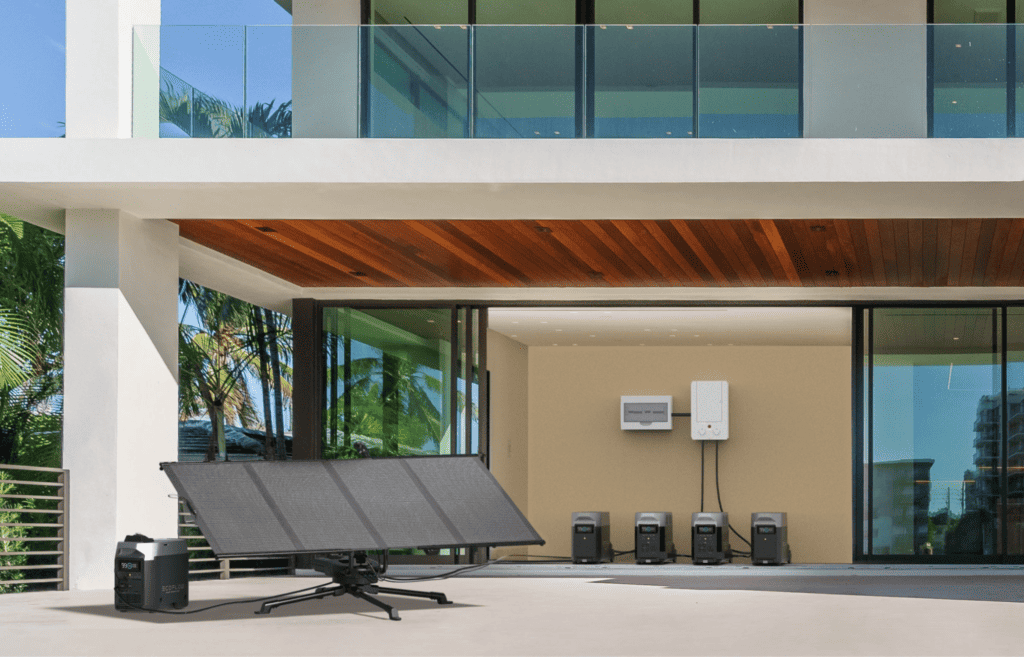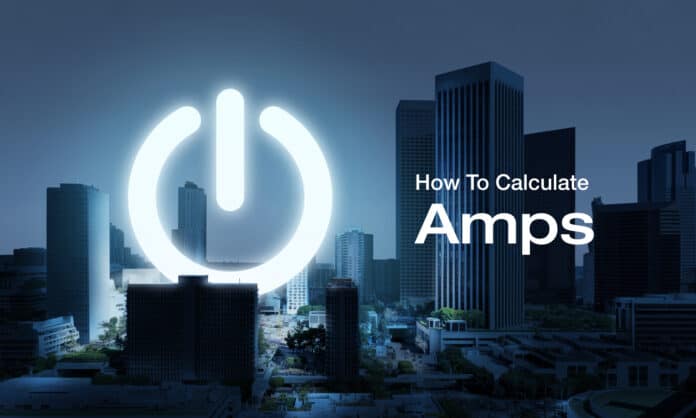Table of Contents
An amp is the unit used to measure current in an electrical system.
There are several ways to calculate amperage using other units of electricity, including watts, volts, and ohms.
In this article, we’ll look at what an amp is, the formula to calculate amps, and why knowing how to determine amperage is valuable.
Keep reading to learn more.
What Is An Amp?
Ampere, commonly shortened to Amp and represented by “A”, is the SI unit used for current. An amp describes the speed of current flow through a circuit. Current is the flow of charge in a conducting material. One amp is equivalent to the movement of 6.24 × 1018 electrons through a point in a conductor in one second.
There are two types of current: direct current (DC) and alternating current (AC).
Direct current flows in one direction, whereas alternating current reverses direction periodically. AC is used to power homes and appliances. DC is to transmit high-voltage current through power lines over long distances. DC electricity is also captured by solar panels and converted to AC using an inverter.
AC and DC electricity are broken down by specific measurements like watts, volts, and amps.
Amps measure the strength of the electromagnetic force resulting from charged particles (electrons) moving from one point to another within a conductor or from one conductive material to another.
The amperage unit is named after André-Marie Ampère, a French physicist who helped develop electromagnetism.
The most commonly known use of amperage is in residential and commercial circuit panels. The circuit breakers inside your home electrical panel are rated by amperage. Most houses have circuit breakers with 15A, 20A, or 30 amps amperes.
A circuit breaker’s amperage rates the amount of current and the speed of electron flow the circuit can handle before tripping. The higher the breaker’s amperage, the more electrical load it can bear.
Low-wattage appliances like televisions and microwaves can operate on a 15A or 20A circuit breaker. High-wattage appliances, such as washing machines and air conditioners, often require a 30A breaker.
In a typical household, a single circuit breaker manages the electrical load of multiple wall outlets. The more appliances you run simultaneously, the greater the amperage required. Operating too many devices at once will cause a circuit breaker to trip.

What Is the Formula for Calculating Amps?
The most straightforward formula for calculating amperage for AC electricity is:
Amperage (A) = Power (W) / Voltage (V)
Based on Ohm’s Law, this formula works on the principle that the speed of electrical current (Amps) equals the ratio of power (watts) to pressure (volts).
For example, a typical Energy Star-rated refrigerator requires 600W of running wattage. Almost all home appliances in the US operate with 120V (volts).
600W / 120V = 5A
A fridge with an amperage of 5A can run on a 15A breaker. But if you’re going to have one circuit breaker for a kitchen with many appliances, you’re much better off going with 30 amps.
It’s also good to know that motor-driven appliances like refrigerators typically require double or more of their rated operating wattage to turn on. This short, additional burst of electricity is called starting watts or surge power and often causes circuit breakers to trip.
How Do You Calculate Amps Without Watts?
In the unlikely event that you don’t know the wattage of an appliance, but you do know the voltage (almost always 120V) and the resistance (ohms), you won’t be able to convert watts to amps, but you can calculate the amperage of the device.
Ohm’s law states:
Current (I) = Voltage (V) / Resistance (ohms or Ω)
Again, using a refrigerator as an example:
120V / 24 Ω = 5A
Appliances rarely (if ever) list ohms or Ω as a spec in product manuals or on product web pages. Resistance can vary based on numerous factors and is a less reliable metric than volts, amps, or watts.
So, how do you calculate ohms?
Unsurprisingly, you use Ohm’s law again by basically rearranging the above formula.
If you know the voltage and amperage of a device, you can calculate ohms using the formula:
Resistance (Ω) = Voltage (V) / Current (I)
Here’s the fridge example:
120V / 5A = 24 Ω
If you’re feeling adventurous and have a device’s wattage and amperage, you can also calculate the ohms by combining the Power Formula and Ohm’s Law.
Confused yet?
Don’t worry about it.
Unless you’re building and testing electronics or looking for faults in electrical circuits using an ohmmeter or multimeter, you’ll never need to calculate amperage without knowing the wattage.
Amps and watts are standard specifications supplied with every electronic device.

Why Is It Useful To Be Able To Calculate Amps?
Among other things, calculating amps can help make decisions about your home’s electrical system, estimate the charging speeds of battery-powered devices, and install residential solar power systems.
Avoid Overloading Your Electrical Circuits
Traditional residential wiring and emergency electricity sources can only handle a specific electrical load before failing.
Your home’s electrical system is likely protected by a circuit board with circuit breakers. The amount of current each breaker can handle without switching off is rated by amperage. Residential circuit breakers are typically rated at 15A, 20A, or 30A.
You’ve probably experienced what happens when you simultaneously try to operate too many appliances on the same circuit. The breaker trips to help ensure your home’s safety.
Without protection from a circuit breaker, overloading your home wiring could easily cause a fire or explosion.
Most high-wattage home appliances and backup power supplies have fuses as an additional layer of protection. Overloading a fuse’s rated amperage will cause it to blow or, at a minimum, shut down the unit.
By calculating the maximum amperage your circuit breakers, appliances, and emergency backup power supply like a portable power station can handle, you can avoid having them shut down and prevent potentially permanent damage.

Connecting Solar Panels and Ensuring System Compatibility
If you’re setting up a solar power system for your home and purchasing a separate balance of system components like an inverter, charge controller, and solar battery, you must ensure that all the parts (and your PV panels) are compatible.
One crucial aspect of determining if your system will perform effectively and safely is ensuring the electrical capacity — including amperage — matches up system-wide.
Accurately calculating your amperage requirements will prevent you from over or undersized electrical components. If the amperage isn’t correct, it will result in reduced (or no) performance and could lead to dangerous electrical hazards.
Additionally, there are two ways of connecting multiple solar panels in an array — series and parallel. Each has pros and cons depending on your electrical requirements.
When connecting solar panels in parallel, the total voltage output remains the same while the amperage produced adds up.
Connect them in series? It’s the opposite — the number of amps remains constant, and the voltage increases.
Knowing how to calculate amps allows you to optimize your solar panel array — and keep your system safe.
One advantage of EcoFlow’s solar generators is that all the required components are built into an all-in-one unit. Just plug in your solar panels, and you’re good to go.

Speed of Charge
You may have noticed that different chargers charge your device faster than others. The difference between the chargers is usually the amp rating. Voltage ensures the device receives enough charge, while amperage controls the speed of the charge.
The battery charges faster at higher amps because it receives energy more quickly. As amperage increases, so does the amount of electricity a device gets, resulting in a faster charge.
However, it’s crucial not to supply any device or system with more than its rated amperage — which also goes for wattage and voltage. Oversupply of electricity can cause permanent damage or fire.
High-amperage batteries come in handy when you need to charge or operate devices or appliances using a backup power solution. EcoFlow’s portable power stations provide high amperage and wattage AC output to run your devices off-grid.
Final Thoughts
Understanding units that measure power, like amps, watts, and volts, is crucial for building electronic devices or planning out electrical systems.
Accurately calculating amperage can make the difference between a device or system that operates safely and efficiently — or even turns on in the first place — and one that doesn’t.
If you’re looking for a reliable off-grid solution that makes backup power simple, check out EcoFlow’s portable power stations today.
